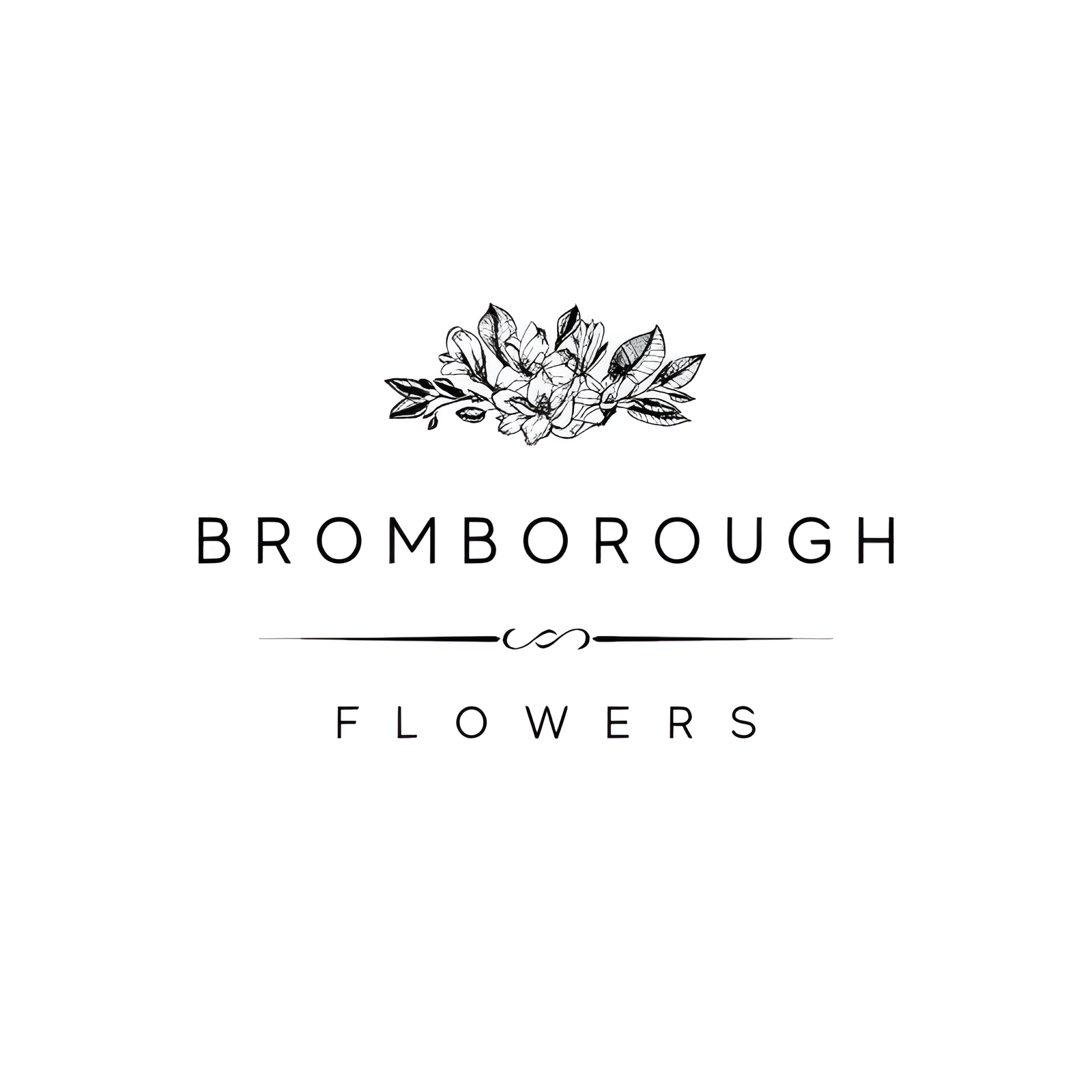When considering floral arrangements for a wedding, succulents stand out for their unique aesthetic and symbolism. Their thick, fleshy leaves and diverse array of shapes and colors, including popular varieties like Echeverias and cacti, offer a contemporary twist on traditional blooms. Known for their resilience and minimal water requirements, succulents are not only visually appealing but also sustainable, making them ideal for bouquets, centerpieces, and even wedding favors. To truly appreciate their versatility and cultural significance, one must explore the various facets that make succulents a sophisticated choice for modern weddings.
Flower Overview
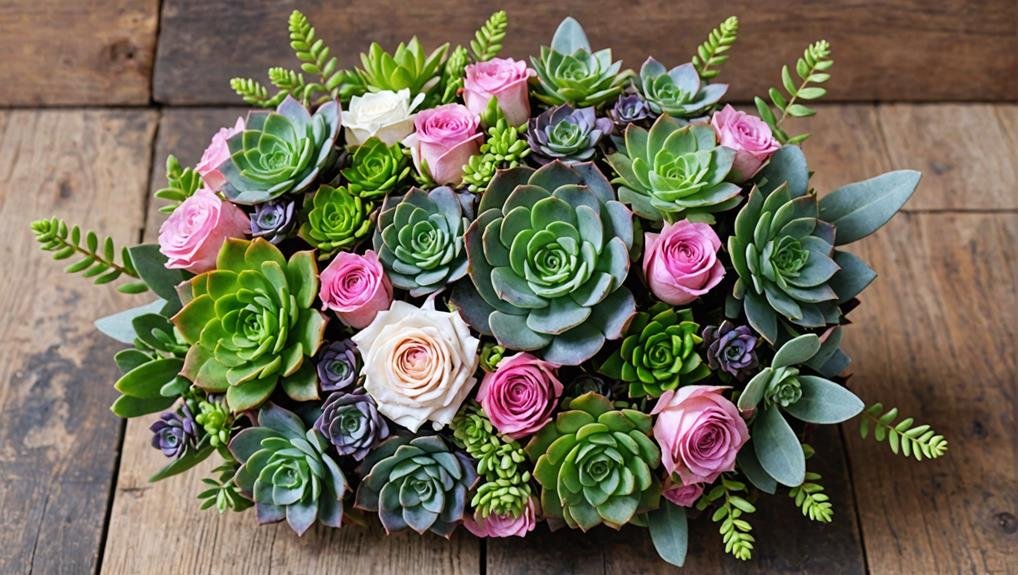
Succulents are unique plants characterized by their thick, fleshy leaves, commonly found in species such as Echeveria Perle von Nurnberg and Mexican Snowball. These plants are highly valued in the world of floral arrangements, particularly for wedding bouquets.
Echeverias, with their vibrant colors and rosette shapes, thrive in semi-desert regions and bring a striking visual appeal to any bouquet. The robust nature of succulents guarantees that they remain fresh and visually appealing longer than many traditional flowers.
Incorporating cacti into succulent bouquets is another popular trend, though it requires careful handling due to their spines. The juxtaposition of the soft, rounded leaves of succulents with the spiky, architectural forms of cacti creates a unique and dynamic floral arrangement.
When forming a succulent bouquet, elements such as balance, color, dominance, scale, and texture are essential for achieving an aesthetically pleasing result. Combining succulents with traditional flowers like roses, lilies, lavender, and baby's breath can enhance the bouquet's elegance and refinement.
To construct a sturdy bouquet, florists often use wire and floral tape to create solid stems for the succulents, making sure the arrangement maintains its shape and integrity.
Physical Description
Characterized by their thick, fleshy leaves that store water, these drought-resistant plants display a diverse array of shapes, sizes, and colors. Succulents are renowned for their adaptability and minimal water requirements, thriving in semi-desert regions. Their physical description varies significantly, offering an extensive palette of forms and textures that make them a versatile choice for wedding floral arrangements.
Among the most popular varieties are the Echeveria species, such as the Perle von Nurnberg and Mexican Snowball. These plants are particularly admired for their vibrant hues and rosette shape, adding a unique aesthetic to any floral design. In addition to the Echeveria species, cacti also fall under the succulent family. While incorporating cacti into arrangements can add an intriguing element, it is essential to handle them with care due to their spines.
Succulents offer the following appealing features:
- Drought-resistant: Ideal for low-maintenance arrangements.
- Varied shapes: From rosettes to columnar forms.
- Diverse textures: Smooth, spiny, or waxy surfaces.
- Size range: From tiny, intricate forms to larger, statement pieces.
- Color spectrum: Extensive, from greens to purples, excluding the next subtopic's focus on specific color varieties.
These attributes make succulents a compelling choice for wedding decor.
Available Colour Varieties
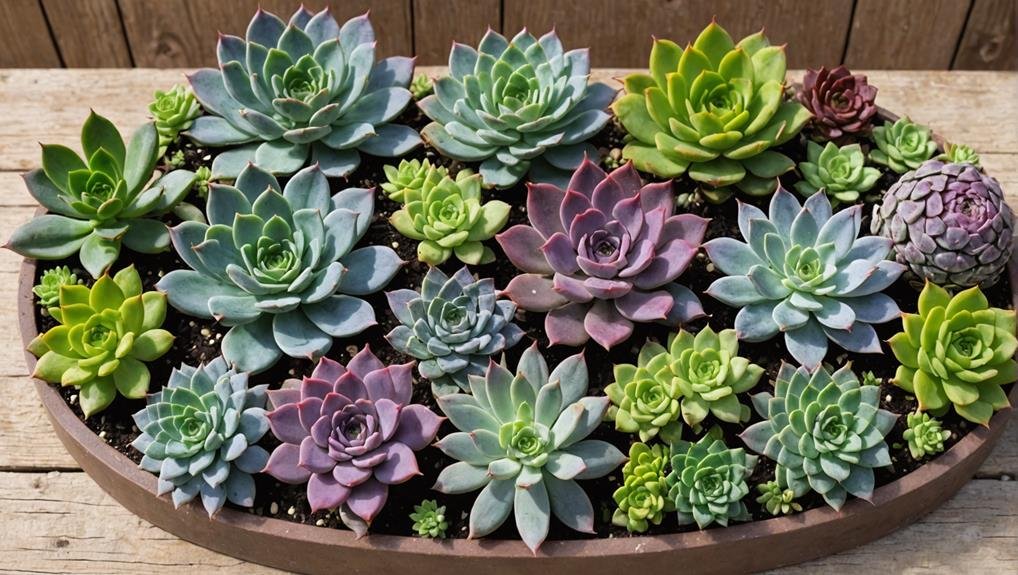
Offering a wide range of hues, succulents come in shades ranging from mint greens to purples and corals, making them versatile additions to wedding floral arrangements. The assortment of succulents available guarantees that there is a perfect match for any wedding theme or color scheme.
Bright green succulents, for instance, can add a fresh and vibrant touch, while gray and purple varieties bring depth and sophistication to bouquets and centerpieces.
Soft pastel-colored succulents are particularly popular for weddings, providing a delicate and romantic touch that blends beautifully with other floral elements. These pastel tones can be seamlessly integrated into arrangements with dahlias, ranunculus, and gerberas, creating stunning and cohesive color combinations.
The wide selection of succulents ensures that couples can find the ideal hues to complement their vision.
Using succulents in wedding floral arrangements not only offers aesthetic appeal but also practical benefits. Succulent care is minimal, as these plants are hardy and long-lasting, making them an excellent choice for enduring wedding decor.
Whether used exclusively or combined with other flowers, the available color varieties of succulents bring a unique and contemporary touch to wedding celebrations.
Latin Name and Taxonomy
Understanding the Latin names and taxonomy of succulents can provide deeper insight into selecting the perfect species for wedding arrangements. Succulents belong to the Crassulaceae family, known for their ability to store water in their thick leaves, a feature that makes them both resilient and visually striking.
Among the various genera, Echeveria stands out as a popular choice for wedding bouquets due to its rosette-shaped leaves and wide range of colors.
Taxonomically, succulents are categorized into several genera, each with unique characteristics that can enhance wedding floral designs:
- Echeveria: Known for its vibrant rosettes and versatility in arrangements.
- Sedum: Offers a variety of shapes and sizes, ideal for adding texture.
- Sempervivum: Often called 'hens and chicks,' perfect for rustic themes.
- Kalanchoe: Features clusters of small flowers, adding a delicate touch.
- Aeonium: Noted for its striking geometric forms and dramatic flair.
Understanding these Latin names and their respective taxonomy helps in making informed choices, ensuring that the selected succulents not only align with the aesthetic vision but also thrive throughout the event.
Whether opting for the vivid hues of Echeveria or the intricate patterns of Sempervivum, the right succulent can elevate the elegance of wedding arrangements.
Geographical Origins
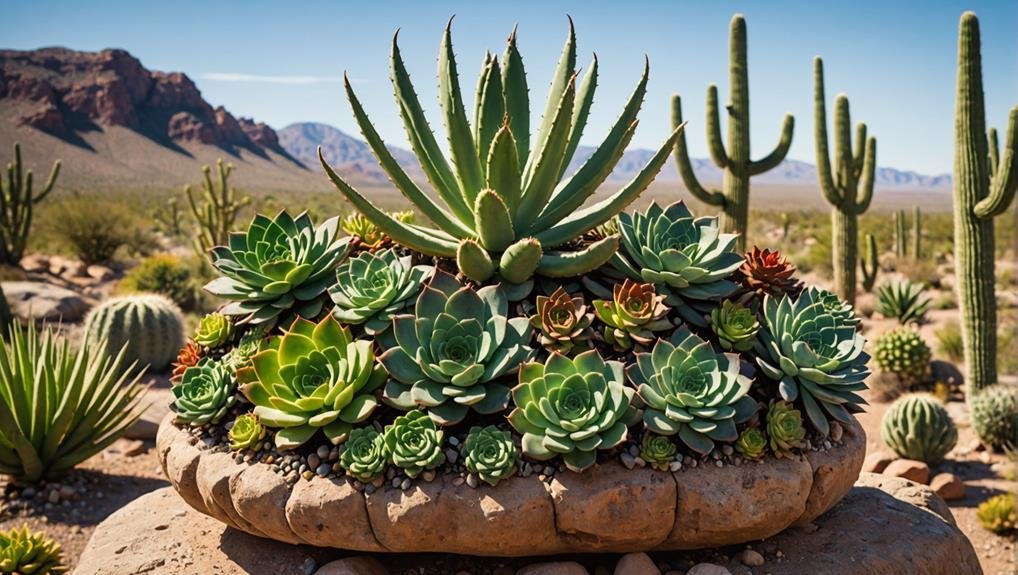
Succulents, with their diverse and fascinating adaptations, originate from a wide array of geographical regions, including deserts, semi-deserts, and arid climates across the globe. Among the most popular succulent species is Echeveria, which hails from regions such as Mexico, Central America, and South America. These areas provide the ideal conditions for Echeveria and other succulent species to thrive, characterized by their ability to store water in their thick, fleshy leaves.
Cacti, a well-known type of succulent, are mainly found in the Americas, particularly within the deserts of North and South America. These plants have evolved to endure extreme temperatures and prolonged periods of drought, making them a common sight in arid environments.
In contrast, succulent species like Haworthia and Aloe are indigenous to Southern Africa, where they flourish in the hot, dry climates of regions such as South Africa and Namibia. Another unique succulent, the string of pearls, is native to the rocky terrains of South Africa and Namibia. These regions, with their harsh conditions, have encouraged the evolution of succulents into a myriad of forms and adaptations, making them a versatile choice for wedding arrangements.
Season Availability
Available year-round, succulents provide an adaptable and reliable option for wedding floral arrangements regardless of the season. Their consistent availability guarantees that couples can enjoy the beauty and charm of succulents at any time of the year, making them a versatile choice for both spring and winter weddings.
While succulents are not tied to a specific season, they can be beautifully paired with seasonal blooms to create personalized arrangements that reflect the time of year. For instance, spring and summer weddings can feature vibrant succulents in full bloom, adding a fresh and lively touch to the décor. Conversely, fall weddings might incorporate succulents with rich and earthy tones, harmonizing with the season's natural palette.
Consider these creative ideas for incorporating succulents into your wedding:
- Pair with seasonal flowers: Combine succulents with flowers that are in season to create a harmonious and timely look.
- Use as boutonnieres: Succulents make excellent boutonnieres that stay fresh throughout the day.
- Create living centerpieces: Utilize potted succulents as centerpieces that guests can take home.
- Incorporate in bouquets: Add succulents to bridal bouquets for texture and visual interest.
- Decorate the cake: Adorn the wedding cake with succulents for a unique and natural touch.
Growing Conditions
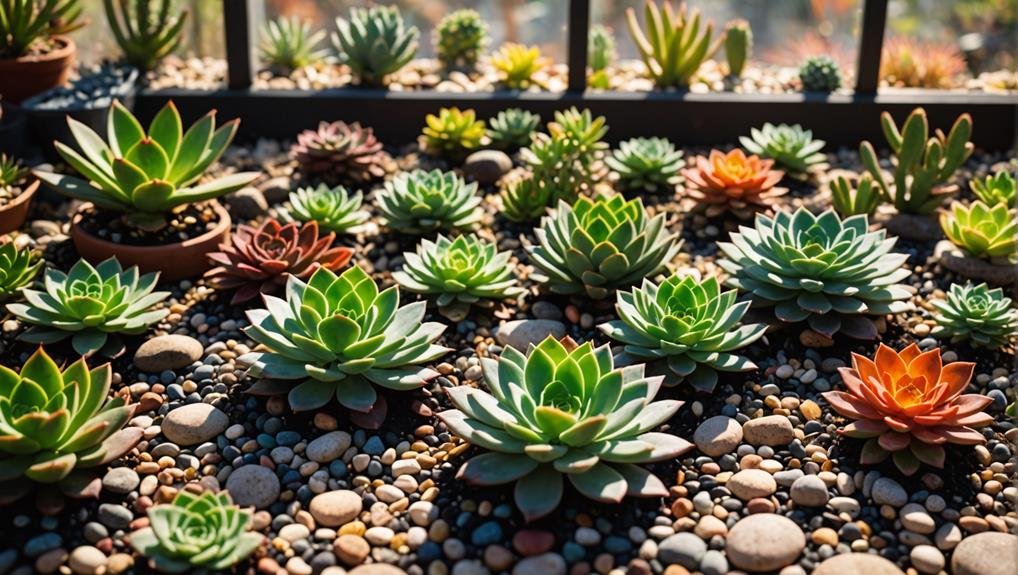
When incorporating succulents into your wedding decor, it's essential to take into account their specific growing conditions to maintain they stay vibrant and healthy. Succulent bouquets are great options due to their hardy nature and minimal care requirements. These plants thrive in well-draining soil, which helps prevent root rot. Ensuring your succulents are planted in soil that drains well is vital for their longevity.
Succulents require plenty of sunlight, ideally at least six hours a day. This abundant light helps them maintain their vibrant colors and compact growth, making them stunning additions to any wedding arrangement. Overwatering is detrimental, as succulents require much less water than other plants. Their roots are prone to rot in soggy conditions, so it's best to let the soil dry out between waterings.
These drought-tolerant plants store water in their leaves, allowing them to go long periods without irrigation. They thrive in temperatures between 60-80°F (15-27°C), making them adaptable to various climates. This resilience makes succulents an excellent choice for wedding decorations.
| Condition | Requirement | Significance |
|---|---|---|
| Soil | Well-draining | Prevents root rot |
| Sunlight | 6 hours per day | Maintains vibrant colors and growth |
| Watering | Minimal | Avoids root rot and overwatering issues |
| Water Storage | In leaves | Allows long periods without irrigation |
| Temperature | 60-80°F (15-27°C) | Adaptable to various climates |
Cultural Significance
In many cultures, the enduring qualities of succulents symbolize everlasting love, unity, and resilience, making them a meaningful addition to weddings. These plants are not only admired for their aesthetic appeal but also for their rich cultural significance. Known for their ability to thrive in harsh conditions, succulents embody resilience, strength, and growth—qualities that are highly desirable in a marriage.
Additionally, succulents are often associated with good luck and prosperity. In several traditions, gifting these hardy plants to newlyweds is believed to bring protection and good fortune as they set out on their new journey together. This symbolism extends beyond mere superstition, reflecting deeper values of sustainability and a connection to nature.
The cultural significance of succulents in weddings can be summarized through the following points:
- Symbolism: Representing resilience, strength, and growth.
- Good Luck: Believed to bring prosperity and protection.
- Resilience: Their ability to withstand harsh conditions mirrors the strength needed in a marriage.
- Sustainability: Reflecting values of environmental consciousness and simplicity.
- Cultural Significance: Rooted in traditions that honor nature and unity.
Incorporating succulents can thus be a beautiful and meaningful way to celebrate the union of two people.
Typical Use in Weddings
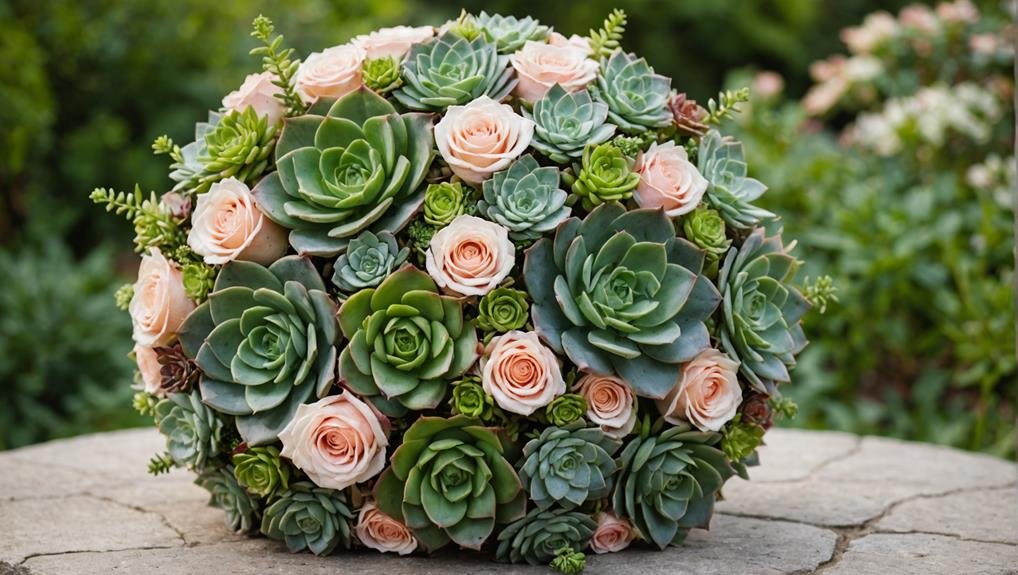
Succulents are widely utilized in weddings for their versatility and ability to enhance various elements of the celebration, from bouquets and boutonnieres to centerpieces and cake toppers. These hardy plants are a popular choice for Wedding Bouquets, offering a unique and modern alternative to traditional floral arrangements. A Succulent Wedding Bouquet not only adds a touch of elegance but also ensures resilience, making it ideal for long wedding days.
Incorporating succulents into Succulent Centerpieces brings a touch of greenery and sophistication to reception tables. Their diverse shapes and colors can complement any wedding theme, from rustic to contemporary. Additionally, succulents serve as memorable Wedding Favors, allowing guests to take a piece of the celebration home with them. Their low maintenance requirements make them perfect for this purpose.
The DIY Approach to using succulents in wedding decor is also gaining popularity. Couples can personalize their wedding arrangements by integrating these versatile plants into various elements, providing a cohesive and eco-friendly aesthetic. Whether used in bouquets, centerpieces, or favors, succulents offer an innovative and sustainable option for modern weddings.
Alternative Flower Types
Many alternative flower types can complement or substitute succulents in wedding arrangements, each bringing their own unique aesthetic and benefits. While succulents like echeveria succulents are durable and require minimal care, other flowers can add diversity and texture to a succulent bouquet or bridal bouquet.
Professional florists often recommend pairing succulents with the following alternatives:
- Roses: Classic and versatile, roses add a touch of elegance and romance. They come in various colors that can match or contrast with succulent flowers.
- Peonies: Known for their lush, full blooms, peonies can add a soft, romantic feel to arrangements, balancing the structured look of succulents.
- Ranunculus: These flowers offer vibrant colors and intricate petal structures, making them an excellent complement to the simplicity of succulents.
- Dahlias: With their bold, intricate blooms, dahlias can create a striking visual contrast to succulent bouquets.
- Baby's Breath: Often used as a filler, baby's breath adds a delicate, airy touch that can enhance the overall arrangement without overshadowing the succulents.
Incorporating these alternatives can elevate the aesthetic appeal of wedding arrangements, providing a balanced mix of textures and colors that enhance the modern charm of succulent flowers.
